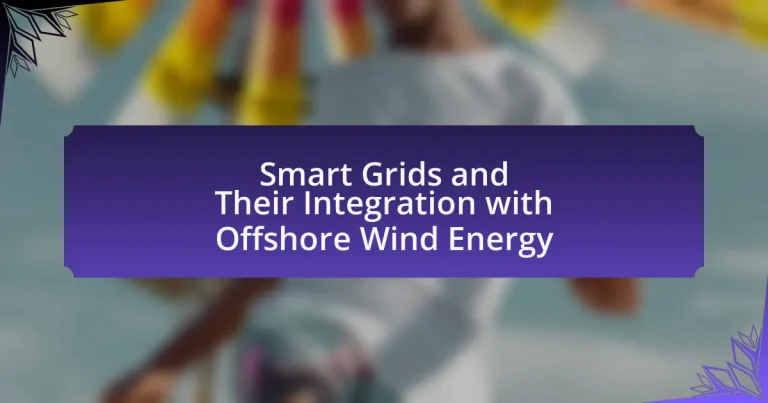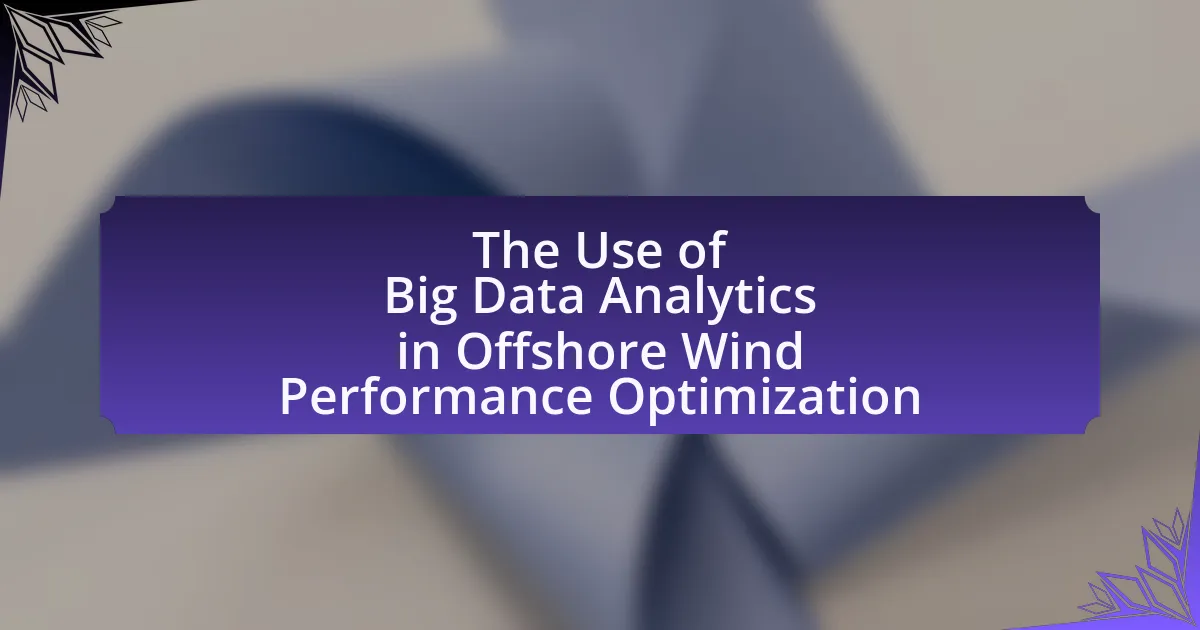Smart grids are advanced electrical systems that leverage digital technology to enhance the management and distribution of electricity from various generation sources, including renewable energy. This article explores the role of smart grids in optimizing energy consumption, integrating offshore wind energy, and improving overall energy efficiency and reliability. Key technologies such as advanced metering infrastructure, demand response systems, and energy storage solutions are discussed, along with the challenges and solutions associated with integrating offshore wind energy into smart grids. Additionally, the article examines future trends, regulatory developments, and innovations that will shape the evolution of smart grids and their synergy with offshore wind energy systems.
What are Smart Grids and Their Role in Energy Management?
Smart grids are advanced electrical grids that utilize digital technology to monitor and manage the transport of electricity from all generation sources to meet the varying electricity demands of end users. They enhance energy management by enabling two-way communication between utilities and consumers, facilitating real-time data exchange, and improving the efficiency and reliability of electricity distribution.
The role of smart grids in energy management includes optimizing energy consumption, integrating renewable energy sources like offshore wind, and reducing operational costs. For instance, smart grids can dynamically adjust energy distribution based on real-time demand and supply conditions, which is crucial for accommodating the variable nature of wind energy generation. This capability is supported by technologies such as smart meters and automated control systems, which collectively contribute to a more resilient and sustainable energy infrastructure.
How do Smart Grids function in modern energy systems?
Smart grids function in modern energy systems by utilizing advanced communication and automation technologies to enhance the efficiency, reliability, and sustainability of electricity distribution. They integrate various energy sources, including renewable energy like offshore wind, by enabling real-time monitoring and management of energy flows, which optimizes energy consumption and reduces waste. For instance, smart grids facilitate demand response programs that adjust energy usage based on supply conditions, thereby balancing load and generation effectively. Additionally, they employ smart meters and sensors to provide consumers with detailed usage data, promoting energy conservation and informed decision-making. This integration of technology not only improves grid resilience but also supports the transition to a low-carbon energy future by accommodating variable renewable energy sources.
What technologies are integral to the operation of Smart Grids?
Smart grids operate through several integral technologies, including advanced metering infrastructure (AMI), demand response systems, distributed energy resources (DER), and communication networks. AMI enables real-time data collection and two-way communication between utilities and consumers, enhancing energy management. Demand response systems allow for the adjustment of consumer energy usage based on supply conditions, optimizing grid efficiency. DER encompasses renewable energy sources like solar and wind, which are crucial for integrating sustainable energy into the grid. Communication networks facilitate the exchange of information across these technologies, ensuring coordinated operation and reliability.
How do Smart Grids enhance energy efficiency and reliability?
Smart Grids enhance energy efficiency and reliability by utilizing advanced communication and automation technologies to optimize electricity distribution and consumption. These systems enable real-time monitoring and management of energy flows, which reduces energy losses and improves the integration of renewable energy sources, such as offshore wind. For instance, according to the U.S. Department of Energy, Smart Grids can reduce peak demand by up to 15%, leading to significant energy savings and increased reliability in power supply. Additionally, Smart Grids facilitate demand response programs that encourage consumers to adjust their energy usage during peak periods, further enhancing overall system efficiency and reliability.
What are the key benefits of Smart Grids?
The key benefits of Smart Grids include enhanced energy efficiency, improved reliability, and increased integration of renewable energy sources. Smart Grids utilize advanced technologies such as sensors and automated systems to optimize electricity distribution, which leads to reduced energy losses and lower operational costs. According to the U.S. Department of Energy, Smart Grids can reduce peak demand by up to 15%, significantly lowering energy costs for consumers. Additionally, they facilitate the integration of renewable energy sources, such as offshore wind, by enabling real-time monitoring and management of energy flows, thus supporting a more sustainable energy future.
How do Smart Grids contribute to renewable energy integration?
Smart Grids enhance renewable energy integration by enabling efficient management of energy flows from diverse sources, including wind and solar. They utilize advanced communication technologies and real-time data analytics to balance supply and demand, facilitating the incorporation of variable renewable energy sources into the grid. For instance, according to the U.S. Department of Energy, Smart Grids can improve grid reliability and reduce the need for fossil fuel backup by up to 30%, thereby supporting a higher penetration of renewables.
What economic advantages do Smart Grids provide to consumers?
Smart Grids provide consumers with significant economic advantages, primarily through enhanced energy efficiency and cost savings. By optimizing electricity distribution and enabling real-time monitoring, Smart Grids reduce energy waste and lower utility bills. For instance, a study by the U.S. Department of Energy found that Smart Grid technologies could save consumers up to $200 billion over the next 20 years by improving grid reliability and reducing outages. Additionally, Smart Grids facilitate the integration of renewable energy sources, such as offshore wind, which can lead to lower energy prices and increased energy independence for consumers.
How do Offshore Wind Energy Systems Integrate with Smart Grids?
Offshore wind energy systems integrate with smart grids through advanced communication and control technologies that enable real-time monitoring and management of energy flow. These systems utilize sensors and data analytics to optimize the generation and distribution of electricity, ensuring that the energy produced by offshore wind farms is efficiently transmitted to the grid. For instance, the integration allows for demand response capabilities, where energy supply can be adjusted based on real-time consumption patterns, enhancing grid stability. Additionally, smart grids facilitate the incorporation of energy storage solutions, which can store excess energy generated during peak production times and release it during periods of high demand, thus improving overall energy reliability and efficiency.
What are the challenges of integrating Offshore Wind Energy into Smart Grids?
Integrating offshore wind energy into smart grids presents several challenges, including grid stability, energy storage, and regulatory issues. Grid stability is affected by the intermittent nature of wind energy, which can lead to fluctuations in power supply that smart grids must manage effectively. Energy storage solutions are necessary to balance supply and demand, as offshore wind generation may not align with peak consumption times. Additionally, regulatory frameworks often lag behind technological advancements, complicating the integration process. These challenges require coordinated efforts among stakeholders to develop robust solutions that ensure reliable and efficient energy distribution.
How does variability in wind energy affect grid stability?
Variability in wind energy significantly affects grid stability by introducing fluctuations in power supply that can lead to imbalances between generation and demand. These fluctuations can cause frequency deviations and voltage instability, which may result in grid disruptions or blackouts if not managed properly. For instance, the integration of wind energy into the grid requires advanced forecasting and real-time management systems to predict and respond to changes in wind generation. Studies have shown that regions with high penetration of wind energy, such as Texas, have implemented grid management strategies, including energy storage and demand response, to mitigate these impacts and maintain stability.
What solutions exist to manage the integration of Offshore Wind Energy?
Solutions to manage the integration of Offshore Wind Energy include the development of smart grids, energy storage systems, and advanced forecasting techniques. Smart grids enhance the efficiency of energy distribution by utilizing real-time data to balance supply and demand, thereby accommodating the variable nature of wind energy. Energy storage systems, such as batteries and pumped hydro storage, provide a means to store excess energy generated during peak production times for use during low production periods. Advanced forecasting techniques improve the predictability of wind energy generation, allowing grid operators to better plan for fluctuations in supply. These solutions collectively enable a more reliable and efficient integration of offshore wind energy into existing energy systems.
What technologies facilitate the integration of Offshore Wind Energy with Smart Grids?
Technologies that facilitate the integration of Offshore Wind Energy with Smart Grids include advanced control systems, energy management systems, and communication technologies. Advanced control systems enable real-time monitoring and optimization of energy flow from offshore wind farms to the grid, ensuring stability and efficiency. Energy management systems help in balancing supply and demand, integrating renewable energy sources effectively. Communication technologies, such as IoT and 5G, enhance data exchange between wind farms and grid operators, allowing for better coordination and response to fluctuations in energy production and consumption. These technologies collectively support the seamless integration of offshore wind energy into smart grid infrastructures, promoting a more resilient and sustainable energy system.
How do energy storage systems support Offshore Wind Energy integration?
Energy storage systems support offshore wind energy integration by providing a means to balance supply and demand, thereby enhancing grid stability. These systems store excess energy generated during peak wind conditions and release it during periods of low generation or high demand, ensuring a consistent power supply. For instance, according to the International Renewable Energy Agency, integrating energy storage with offshore wind can increase the utilization of wind energy by up to 30%, significantly reducing curtailment losses. This capability not only optimizes the use of renewable resources but also facilitates the transition to a more resilient and flexible energy grid.
What role do advanced forecasting tools play in this integration?
Advanced forecasting tools are essential in the integration of smart grids with offshore wind energy as they enhance the accuracy of energy production predictions. These tools utilize sophisticated algorithms and real-time data to forecast wind patterns and energy output, allowing grid operators to optimize energy distribution and manage supply-demand balance effectively. For instance, studies have shown that accurate forecasting can improve grid reliability by up to 30%, reducing the risk of outages and ensuring a stable energy supply.
What are the Future Trends in Smart Grids and Offshore Wind Energy Integration?
Future trends in smart grids and offshore wind energy integration include increased digitalization, enhanced energy storage solutions, and improved grid resilience. Digitalization enables real-time data analytics and advanced communication technologies, facilitating better management of energy flows from offshore wind farms. Enhanced energy storage solutions, such as batteries and pumped hydro storage, are critical for balancing supply and demand, especially given the intermittent nature of wind energy. Improved grid resilience is achieved through the implementation of smart grid technologies that allow for better monitoring and control, reducing the risk of outages and enhancing the overall reliability of the energy system. These trends are supported by ongoing investments in renewable energy infrastructure and regulatory frameworks promoting clean energy integration.
How is the regulatory landscape evolving for Smart Grids and Offshore Wind Energy?
The regulatory landscape for Smart Grids and Offshore Wind Energy is evolving towards increased integration and support for renewable energy sources. Governments and regulatory bodies are implementing policies that promote the development of smart grid technologies, which enhance the efficiency and reliability of energy distribution while facilitating the integration of offshore wind energy into the grid. For instance, the European Union’s Clean Energy for All Europeans package aims to create a more flexible energy system, encouraging investments in smart grid infrastructure and offshore wind projects. Additionally, the U.S. Federal Energy Regulatory Commission has introduced initiatives to streamline interconnection processes for offshore wind farms, thereby accelerating their deployment and integration into existing energy systems. These regulatory changes reflect a broader commitment to achieving energy transition goals and reducing carbon emissions.
What policies are being implemented to promote this integration?
Policies being implemented to promote the integration of smart grids with offshore wind energy include regulatory frameworks that incentivize investment in renewable energy infrastructure and technology. For instance, many governments are establishing feed-in tariffs and power purchase agreements that guarantee fixed prices for electricity generated from offshore wind, encouraging developers to invest in smart grid technologies that enhance energy distribution and management. Additionally, initiatives such as the European Union’s Green Deal aim to create a more interconnected energy system, facilitating the integration of offshore wind into existing grids through funding and support for innovative grid solutions. These policies are designed to reduce carbon emissions and enhance energy security, demonstrating a commitment to transitioning towards sustainable energy sources.
How do international collaborations impact the development of Smart Grids?
International collaborations significantly enhance the development of Smart Grids by facilitating knowledge exchange, technological innovation, and resource sharing among countries. These partnerships enable the integration of diverse expertise and best practices, which accelerates the deployment of advanced grid technologies. For instance, the European Union’s Horizon 2020 program has funded numerous projects aimed at improving Smart Grid systems, demonstrating how collaborative efforts can lead to substantial advancements in grid efficiency and reliability. Additionally, international collaborations often result in standardized protocols and interoperability frameworks, which are crucial for the seamless integration of renewable energy sources, such as offshore wind energy, into existing grid infrastructures.
What innovations are on the horizon for Smart Grids and Offshore Wind Energy?
Innovations on the horizon for Smart Grids and Offshore Wind Energy include advanced energy management systems, enhanced grid resilience through artificial intelligence, and improved energy storage solutions. These innovations aim to optimize the integration of offshore wind energy into existing power grids, facilitating better demand response and load balancing. For instance, the deployment of AI algorithms can predict energy production from offshore wind farms, allowing for more efficient grid operations. Additionally, the development of next-generation battery technologies, such as solid-state batteries, promises to enhance energy storage capacity and reliability, which is crucial for managing the intermittent nature of wind energy.
How might artificial intelligence enhance Smart Grid operations?
Artificial intelligence can enhance Smart Grid operations by optimizing energy distribution and improving demand response. AI algorithms analyze vast amounts of data from various sources, enabling real-time decision-making that adjusts energy flow based on consumption patterns and grid conditions. For instance, AI can predict peak demand periods, allowing grid operators to allocate resources more efficiently, which can lead to a reduction in energy waste and lower operational costs. Studies have shown that implementing AI in Smart Grids can increase efficiency by up to 30%, demonstrating its significant impact on operational performance.
What advancements in offshore wind technology could improve integration?
Advancements in offshore wind technology that could improve integration include the development of floating wind turbines, enhanced energy storage systems, and advanced grid management software. Floating wind turbines allow for deployment in deeper waters, capturing stronger and more consistent winds, which increases energy generation potential. Enhanced energy storage systems, such as lithium-ion batteries and pumped hydro storage, enable better management of energy supply and demand, facilitating smoother integration into existing power grids. Advanced grid management software utilizes real-time data analytics and machine learning to optimize energy distribution and improve grid stability, ensuring that offshore wind energy can be effectively integrated into smart grids. These advancements collectively enhance the reliability and efficiency of offshore wind energy integration.
What best practices should be followed for effective integration of Smart Grids and Offshore Wind Energy?
Effective integration of Smart Grids and Offshore Wind Energy requires the implementation of advanced communication technologies, robust data management systems, and coordinated regulatory frameworks. Advanced communication technologies, such as IoT and real-time monitoring systems, facilitate seamless data exchange between wind farms and grid operators, enhancing operational efficiency. Robust data management systems enable the analysis of energy production and consumption patterns, allowing for better forecasting and grid stability. Coordinated regulatory frameworks ensure that policies support the integration process, addressing challenges like grid interconnection and energy market participation. These practices are essential for optimizing the performance and reliability of both Smart Grids and Offshore Wind Energy systems.




